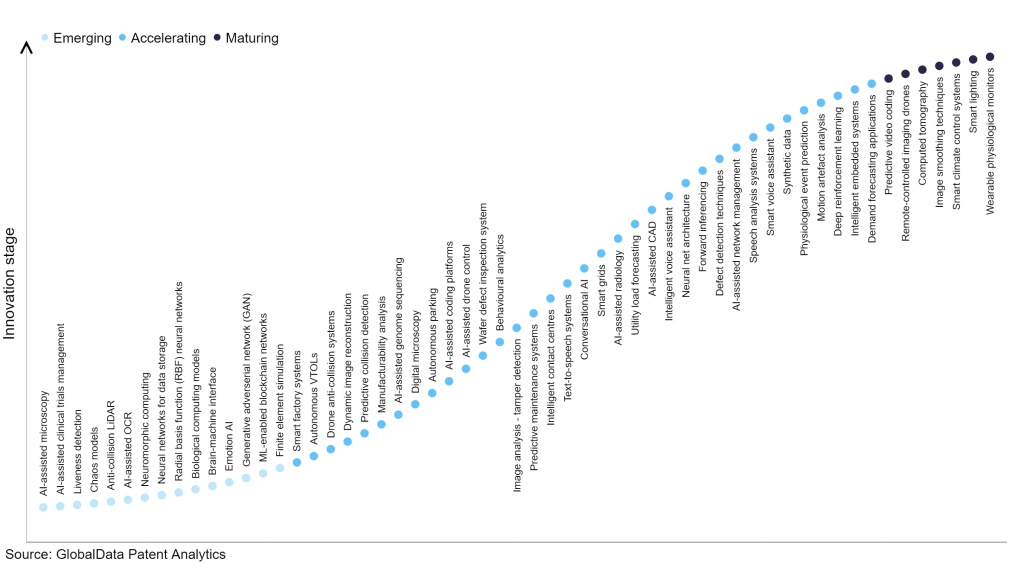The technology industry continues to be a hotbed of innovation, with activity driven by the amalgamation of technological progress, heightened connectivity, and the urgency for businesses to enhance efficiency and competitiveness in an ever-changing marketplace, as well as growing importance of technologies such as machine learning, deep learning, natural language processing, and augmented and virtual reality. These technologies empower radiologists with advanced tools for image analysis, diagnosis, treatment planning, and improving patient care outcomes. In the last three years alone, there have been over 3.6 million patents filed and granted in the technology industry, according to GlobalData’s report on Innovation in Artificial Intelligence: AI-assisted radiology. Buy the report here.
However, not all innovations are equal and nor do they follow a constant upward trend. Instead, their evolution takes the form of an S-shaped curve that reflects their typical lifecycle from early emergence to accelerating adoption, before finally stabilising and reaching maturity.
Identifying where a particular innovation is on this journey, especially those that are in the emerging and accelerating stages, is essential for understanding their current level of adoption and the likely future trajectory and impact they will have.
300+ innovations will shape the technology industry
According to GlobalData’s Technology Foresights, which plots the S-curve for the technology industry using innovation intensity models built on over 2.5 million patents, there are 300+ innovation areas that will shape the future of the industry.
Within the emerging innovation stage, finite element simulation, ML-enabled blockchain networks, and generative adversarial network (GAN) are disruptive technologies that are in the early stages of application and should be tracked closely. Demand forecasting applications, intelligent embedded systems, and deep reinforcement learning are some of the accelerating innovation areas, where adoption has been steadily increasing. Among maturing innovation areas are, wearable physiological monitors, smart lighting, and smart climate control systems, which are now well established in the industry.
Innovation S-curve for artificial intelligence in the technology industry

AI-assisted radiology is a key innovation area in artificial intelligence
AI-assisted radiology refers to the application of artificial intelligence (AI) technologies to support radiologists in tasks like image analysis, diagnosis, and patient care. These systems harness AI algorithms to aid in detecting abnormalities, expediting image review, and enhancing the precision and consistency of diagnoses. By alleviating the workload on radiologists, this technology enables them to concentrate on more intricate cases, ultimately enhancing overall efficiency and patient outcomes.
GlobalData’s analysis also uncovers the companies at the forefront of each innovation area and assesses the potential reach and impact of their patenting activity across different applications and geographies. According to GlobalData, there are 870+ companies, spanning technology vendors, established technology companies, and up-and-coming start-ups engaged in the development and application of AI-assisted radiology.
Key players in AI-assisted radiology – a disruptive innovation in the technology industry
‘Application diversity’ measures the number of different applications identified for each relevant patent and broadly splits companies into either ‘niche’ or ‘diversified’ innovators.
‘Geographic reach’ refers to the number of different countries each relevant patent is registered in and reflects the breadth of geographic application intended, ranging from ‘global’ to ‘local’.
Patent volumes related to AI-assisted radiology
Source: GlobalData Patent Analytics
Koninklijke Philips is one of the leading patents filers in AI-assisted radiology. The company’s patents are aimed at a medical imaging system configured to link acquired images to markers or tags on an anatomical illustration based on spatial and anatomical data associated with the acquired image.
The medical imaging system may be further configured to generate a diagnostic report including the anatomical illustration containing the markers. The diagnostic report may allow a user to select a marker to view information associated with an acquired image. Multiple images may be associated with a marker, and/or multiple markers may be associated with an image. A set of 2D/3D anatomical illustrations may be generated which contains markers from multiple diagnostic reports and updated automatically for an individual patient's anatomical model by the application to reflect measurements and quantitative findings related to organ, tissue, and vessel size, location, deformation, or obstruction.
Other prominent patent filers in the AI-assisted radiology space include Siemens and Fujifilm .
In terms of geographical reach, Magic Leap leads the pack, followed by Sung Kwang Medical Foundation and VPIX Medical. In terms of application diversity, Neurent Medical holds the top position, followed by Masimo and Caris Life Sciences.
AI-assisted radiology has potential to improve efficiency, accuracy, and patient outcomes in medical imaging. By augmenting the capabilities of radiologists, this technology has the power to transform the field by enabling faster diagnoses, more accurate interpretations, and informed decision-making, ultimately leading to enhanced healthcare delivery.
To further understand how artificial intelligence is disrupting the technology industry, access GlobalData’s latest thematic research report on Artificial Intelligence (AI) – Thematic Intelligence.
Data Insights
From

The gold standard of business intelligence.
Blending expert knowledge with cutting-edge technology, GlobalData’s unrivalled proprietary data will enable you to decode what’s happening in your market. You can make better informed decisions and gain a future-proof advantage over your competitors.







